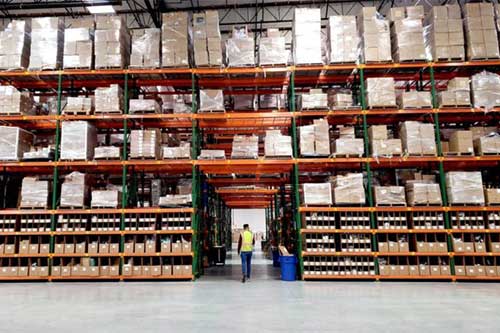
The integration of Automated Guided Vehicles (AGVs) presents a compelling opportunity across various sectors within the e-commerce landscape. Specifically, AGVs excel in fulfillment operations characterized by the processing of numerous small orders across extensive SKU ranges within sprawling warehouse facilities. Leveraging autonomous robots for horizontal movement enhances the efficiency of order fulfillment processes, enabling warehouses to meet escalating demands with greater agility.
The advent of an ever-active e-commerce ecosystem has intensified the need for swift responses and streamlined management of a burgeoning array of stock-keeping units, while simultaneously minimizing errors. Warehouses are compelled to evolve into intelligent, efficient, and automated hubs to align with evolving industry standards. This imperative is further fueled by the surge in globalization and the proliferation of online and bulk retail, which has significantly augmented the demand for AGVs across the retail sector.
The escalating demand placed on e-commerce entities to accommodate the burgeoning volume of same-day delivery orders, spanning both mature and emerging markets, has precipitated a notable surge in operational efficiency. This surge is underpinned by the economic viability of expedited delivery schemes, facilitated by the integration of AGVs within e-commerce warehouse operations. Notably, India's e-commerce industry is poised for substantial growth, with market projections anticipating a USD 350 billion valuation by 2030, as per insights from the IBEF.
In the United States, retail e-commerce sales surged to nearly USD 269.5 billion in the second quarter of 2023, marking a 6.6 percent increase from the preceding quarter, according to from the U.S. Census Bureau. The dynamic evolution of the retail landscape necessitates distribution centers to adopt innovative, adaptable, and automated strategies for e-commerce order fulfillment. The escalating volume of online transactions underscores the imperative for companies to integrate automated material handling equipment into their operational workflows to ensure seamless operations.
Furthermore, the deployment of AGVs in distribution centers has proven instrumental in sustaining high productivity levels amidst heightened e-commerce demands. Beyond traditional retail, AGVs find application in sectors such as pharmaceuticals, where they play a pivotal role in meeting escalating demands while upholding stringent sanitation standards. Notably, hospitals and healthcare facilities leverage AGVs for contactless transfer of essential supplies, including food, waste bins, linens, and sterile equipment, underscoring the versatile utility of AGVs across diverse industries.
Enhanced Efficiency Through Automation
The traditional manual processes of e-commerce warehousing are increasingly being replaced by sophisticated automation solutions. Automated systems, powered by cutting-edge technologies such as robotics, and machine learning, offer unparalleled speed, accuracy, and scalability. From order fulfillment and inventory management to packing and shipping, automation optimizes every aspect of warehouse operations, resulting in faster turnaround times, reduced errors, and enhanced customer satisfaction.
Key Benefits of Automation
The integration of automation brings a multitude of benefits to e-commerce warehouses:
Increased Speed and Accuracy: Automated systems expedite order processing and minimize errors, ensuring swift and precise fulfillment of customer orders.
Optimized Space Utilization: Automated storage and retrieval systems maximize warehouse space utilization, allowing businesses to store more inventory in less space and accommodate growing product portfolios.
24/7 Operations: Automation enables round-the-clock warehouse operations, facilitating continuous order processing and fulfillment to meet the demands of today's always-on consumer culture.
Scalability: Scalable automation solutions can easily adapt to fluctuations in demand, allowing e-commerce businesses to efficiently scale their operations up or down as needed without compromising efficiency or productivity.
Labor Savings: By automating repetitive and labor-intensive tasks, e-commerce warehouses can significantly reduce labor costs and reallocate human resources to more strategic roles that require creativity and critical thinking.
Technological Advancements Driving Automation
The advancement of automation technologies continues to drive innovation in e-commerce warehousing:
Robotics: Autonomous mobile robots (AMRs) and robotic arms are revolutionizing order picking, packing, and palletizing processes, enhancing speed, accuracy, and efficiency.
Warehouse Management Systems (WMS): Cloud-based WMS platforms integrate seamlessly with automation solutions, providing real-time visibility into inventory levels, order statuses, and warehouse performance metrics.
IoT and RFID Technology: Internet of Things (IoT) sensors and Radio-Frequency Identification (RFID) tags enable real-time tracking and monitoring of inventory movements, enhancing inventory accuracy and supply chain visibility.
Real-World Implementations
Leading e-commerce giants and logistics providers are already reaping the benefits of automation in their warehouse operations:
Amazon: Amazon's fulfillment centers are equipped with a vast array of robotic systems, including Amazon Robotics' fulfillment robots, which navigate warehouse aisles to pick up and transport inventory items to human workers for packing and shipping.
Alibaba: Alibaba's smart warehouses utilize driven robots for automated sorting, packing, and order fulfillment, enabling rapid processing of millions of orders daily.
UPS: UPS employs automated guided vehicles (AGVs) and robotic sorting systems in its distribution centers to streamline package handling and optimize delivery routes, enhancing operational efficiency and reducing delivery times.
The automation upgrading of e-commerce warehouses is revolutionizing the way goods are stored, picked, packed, and shipped, driving efficiency, scalability, and customer satisfaction to new heights. As technology continues to evolve, e-commerce businesses must embrace automation as a cornerstone of their warehouse strategy to remain competitive in the fast-paced world of online retail.